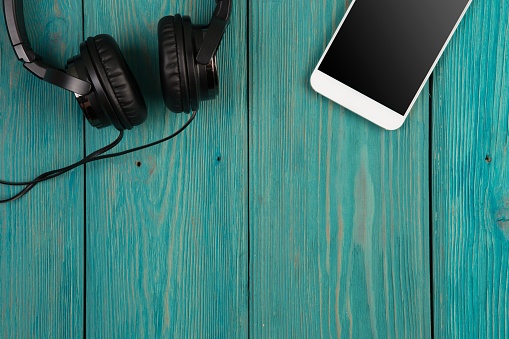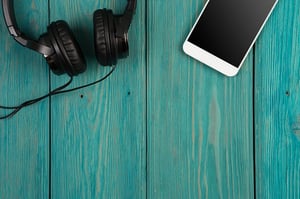
7 Steps For Creating Your Own Podcast
Lessons Learned From A First-Time Podcast Producer
 Considering starting your own podcast?
Considering starting your own podcast?
First, let’s look at the stats:
- More than 550,000 podcasts are available for listening in over 100 languages (Variety)
- Over 18.5 million episodes have been produced (Fast Company)
- 4o% of the U.S. population has listened to a podcast (Edison Research)
- 80% of podcast listeners said they consumed “all” or “most” of each episode they downloaded (Edison Research)
Based on these stats, we were all-in when it came to launching our first podcast, Smash The Funnel. We knew it was a great opportunity to reach our target audience via a format that was easily accessible and digestible for them.
But once we said, “Yup! We’re creating a podcast,” we had to research, plan and execute on a marketing format that was brand new to us.
If you’re thinking of starting your own podcast, here’s what we learned from researching, planning, executing and launching our first season of Smash The Funnel: The Podcast.
1) Determine Your Format
When determining your format, there are two main approaches:
Episodic: This delivers a new episode based on your determined frequency (daily, weekly, monthly, etc.). This format gives you the opportunity to schedule guests based on their availability and not your series order. It also opens the door to record episodes on hot topics that may have a short “shelf life.”
Serial: This Netflix-style format delivers all of the episodes for an entire season at one time. If you plan to have your podcast season tell a story and be threaded together one after the next, the serial approach is a great one. It allows for you to record all of the episodes and then release them in one season so listeners can binge on the content if they choose.
Both formats work, and each has pros and cons, so it’s important to consider both your audience and content before picking which format will work best for you.
We wanted to make our podcast easy to listen to for our persona, who is always on the go. For that reason, we went with the serial approach, where we released all 10 episodes of season one at the same time.

2) Identify Your Content Focus
You can find podcasts about pretty much anything imaginable. Couponing, Grey’s Anatomy episode reviews, video games – you name it, it’s probably out there. That’s why we highly encourage you to not create a podcast just for the sake of creating a podcast.
Before decided on your content focus, ask yourself:
- Am I am expert in a specific topic or area?
- What is the core pain or interest area for my target audience?
- Do I have something groundbreaking that could change my industry?
We leaned into the latter two questions. We knew are target audience and their daily pains, and we knew our introduction of the Cyclonic Buyer JourneyTM was a groundbreaking concept for sales and marketing.
So for us, the choice was easy. We decided to focus our first season on introducing the Cyclonic Buyer Journey to our audience, dedicating each episode to exploring a different stage of the buyer journey.
For you, making the decision might not come so quickly, but don’t let that frustrate you. The outcome and quality of the content will be so much more powerful if you’re all-in on your area of focus.
Don’t rush this step, as it could make the difference between your podcast being wildly successful or a huge failure.
3) Secure Equipment And Software
With any job, identifying the right tools is essential. You wouldn’t purchase an axe to replace your kitchen sink, right? The same goes for the tools and equipment needed to create your first podcast.
Prior to recording episodes, we talked with other podcast hosts and did our own research to identify the tools we needed. We found that the following were essentials to get started:
- Computer
- Recording software
- Microphone
- Editing software
- Hosting platform
These are just the basics, but it’s enough to get you started. To learn about more advanced equipment, check out Podcast Insights.
The quality of your equipment could make or break your podcast. At Square 2 Marketing, we used the following for our first season:
- Computer: MacBook Air
- Recording software: Zoom Meetings
- Microphone: Blue Yeti USB mic with windscreen
- Editing software: Camtasia
- Hosting: Podbean
In full transparency, all of the tools we chose worked for us except for the microphone. The audio quality wasn’t optimal, and in some instances, our guests sounded better than our host. But we’re using this as a live-and-learn opportunity, and we’ll be using a new microphone when we record season 2 of Smash The Funnel: The Podcast.
It’s important to note that what worked for us might not work for you, and that’s OK. You need to test your equipment just like you would test your marketing initiatives and see what performs best for you.
4) Identify And Invite Your Guests
 Step 4 might just be the most important step in this list. You have the format, the content focus and the equipment, but you can’t have a podcast without guests.
Step 4 might just be the most important step in this list. You have the format, the content focus and the equipment, but you can’t have a podcast without guests.
For season 1, we knew we needed 10 guests – eight guests to represent each stage of the Cyclonic Buyer Journey, one guest for the introduction episode and one guest to talk about data’s impact on the stages. To identify our guests, we first mapped out the ideal focus for each episode, and then we looked at the possibilities from a few different directions.
Influential people in sales and marketing
As marketers, we follow other marketers via their blogs and podcasts as well as on social media. So it was fairly easy for us to come up with a list of influential people who we felt would be a good fit for season 1.
Our best recommendation is to start here and develop a list of “dream guests.” These are people who you think will have the best stories and insights to share with your audience. Think about the saying “go big or go home” – that’s the approach we took.
Our networks
Once we had the list of influential people, we scoured our networks. We leveraged LinkedIn heavily for this and looked at first connections. To our, surprise it worked, and we were able to book six of our 10 guests this way.
Our network’s network
After we locked in the initial guests based on our networks, we went a layer deeper and looked at second connections in LinkedIn for opportunities to ask others to make connections for us. This approach also worked well, and were able to secure three more guests with just a simple introduction by our connection and an invite from us.
Authors who recently released books on related topics
Amazon was an amazing resource for this approach. Do a simple search via Amazon for books by topic and then sort by date. You’ll get the most recent books on that topic. From there, it’s just a matter of finding the author’s contact information via their website and reaching out. This is a very “cold-calling” approach, but we had success with it.
For each of these approaches, we crafted an email template that provided an overview of the podcast and what we were trying to accomplish. We highlighted what episode we felt they would be best for and also provided an overview of their anticipated time commitment. We customized this email for each recipient and adjusted as needed when sending via LinkedIn.
Having the template was a great starting point, but the customization was key.
I have to admit, when we booked guest #10, I did a happy dance (there might have even been a fist pump or two). I was pumped; the hardest part was over (at least for season 1). I hope that you have the same celebration when you lock in your first guests.
5) Record And Edit
Now it’s time to schedule and record each episode. Some keys to consider:
- Schedule each episode recording just like you would any other meeting by sending a calendar invite with a link to where you will record (such as Zoom or Skype).
- A few days before the scheduled recording, send an overview of what you hope to cover in the episode. This could include a few sample questions as a guideline so your guest knows exactly what you plan to discuss with them.
- Before you start recording, spend a few minutes with your guest to break the ice. In some instances, this might be the first time you have ever spoken to them live. You want to make them feel comfortable, so that the conversation flows naturally when you hit record.
Our number #1 tip at this step is to make sure you hit record so you capture all of the greatness that comes out of the conversation – that is just something you can’t recreate.
We’re going to leave editing a little open-ended, as you could take so many different approaches. Here are just a few:
- Raw cut: No edits and no intro, just the recording as is.
- Basic edit: In-house recorded intro, plus the addition of purchased stock music and basic audio production (mostly slicing audio at the beginning and end of the episode).
- Highly edited: A professional voice-over introduction, customized music, professional audio production and more.
There’s no right or wrong answer here; it’s really about the format and final product you’re looking to achieve.
6) Launch
Now it’s time to get your podcast live! As mentioned in step 3, you’ll need a podcast hosting location. We used Podbean, but many other options are available. Just be sure the hosting solution you choose provides an RSS feed, as this is required to launch on iTunes.
Once your episodes are edited, you’ll need to upload them to your hosting site, and then you can start pushing out to various podcast players. We started with these players:
Here’s a link to what Podcast Insights has identified as the best podcast listening apps (for iOS and Android) in 2018.
As a warning, you’ll need to follow different steps to get launched in each of these players. Additionally, some players have a waiting period. Be sure to read the details on their sites to know what to expect. It’s best to do this research in advance so you’re not scrambling at the end.
7) Promote
Once you’re up and running, you can start promoting your podcast, and the possibilities are endless. Here are some ideas to get you started:
- Weekly social media promotion: Promote via your company social channels, and ask your team to promote as well.
- Guest promotion: Send an email letting your guests know that their episode is live, and ask them to share via their network and channels. It’s always a good idea to send them links, sample posts and even graphics to make it as easy as possible to share and promote.
- Blogging: Write a blog announcing the launch of your podcast, so that your blog followers can also take advantage of your podcast. As an example, here is a link to the blog we published promoting our podcast.
- Be a guest: The best way to promote your podcast is to be a guest on other podcasts. You can leverage your industry expertise and often (with approval from the host) plug your podcast at the closing.
- Podcast transcript turned blog post: If you use a tool like Zoom to record your podcast, it automatically creates a transcript of the recording. You can then leverage this to create a blog for each episode, giving you another opportunity to promote your podcast to your blog followers. Also don’t forget the added SEO value here – it’s a win-win.
That’s A Wrap
While seven steps many not seem like a lot, producing your first podcast isn’t a quick and easy task. It takes time, dedication and practice to get it just right. We’re still learning!
If you’ve been considering launching your own podcast, we encourage you to take the plunge. You’ll learn a lot and provide your company with a whole new medium to reach your target audience.

CEO and Chief Revenue Scientist
Mike Lieberman, CEO and Chief Revenue Scientist
Eliminate Hit-or-Miss Marketing Moves
Get advice, tips, tools and guidance to generate more leads for your company in this weekly email newsletter.



Eliminate Hit-or-Miss Marketing Moves
Get advice, tips, tools and guidance to generate more leads for your company in this weekly email newsletter.













